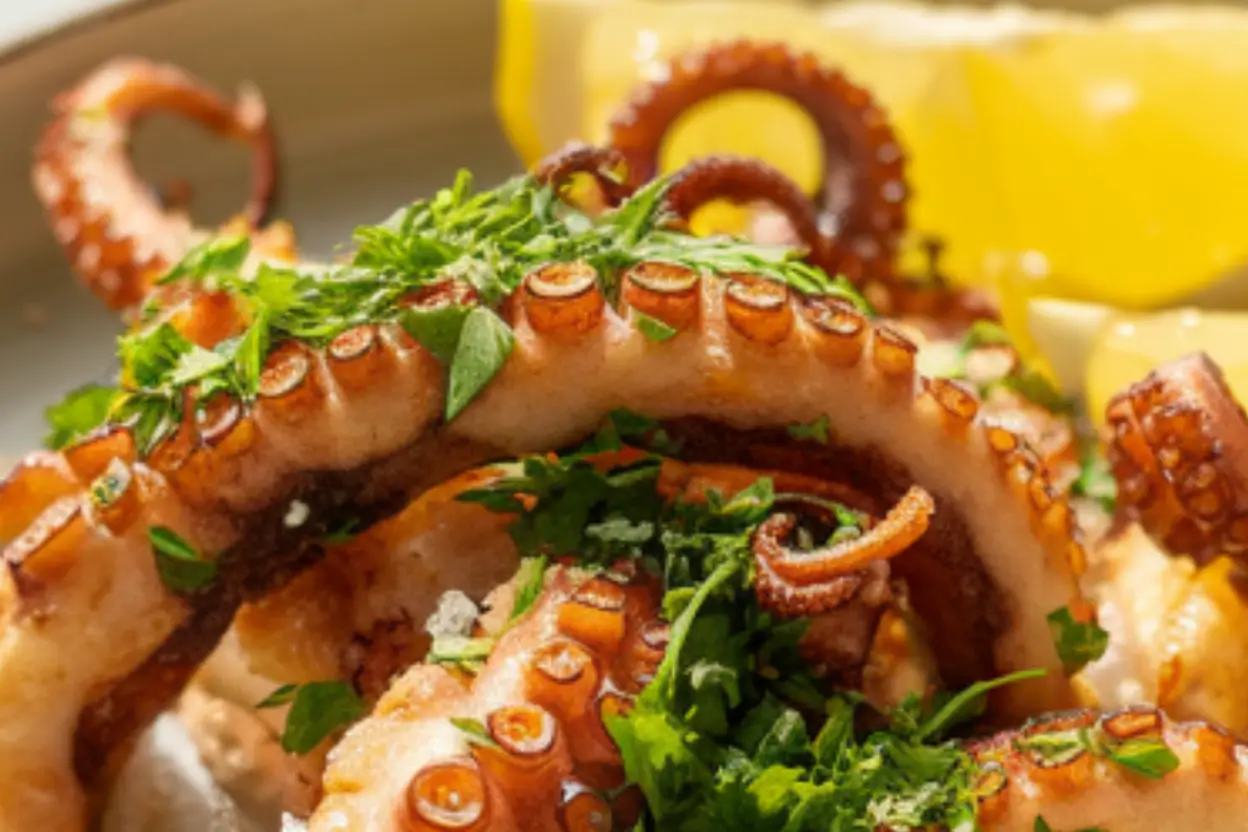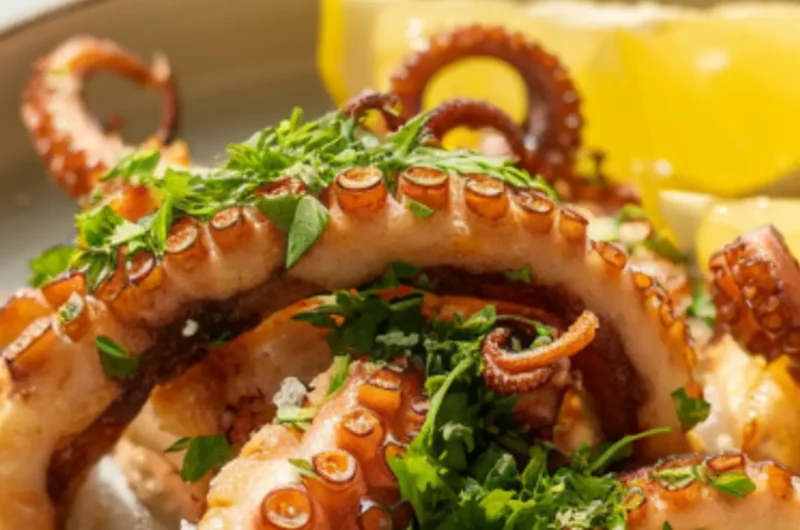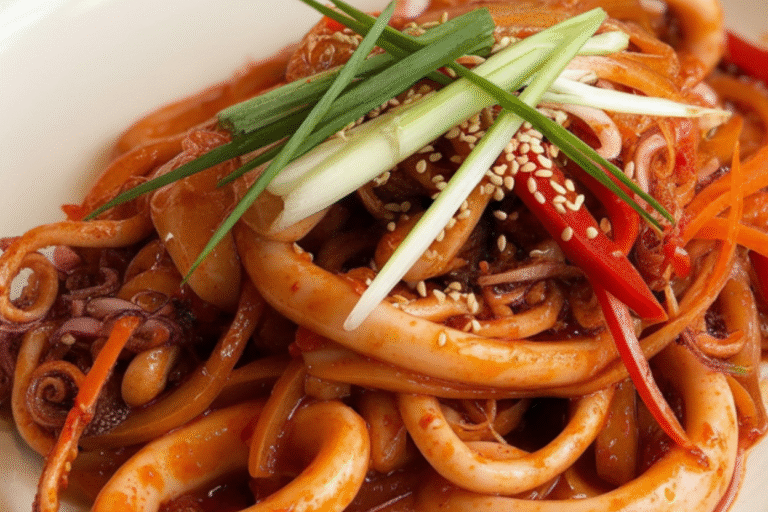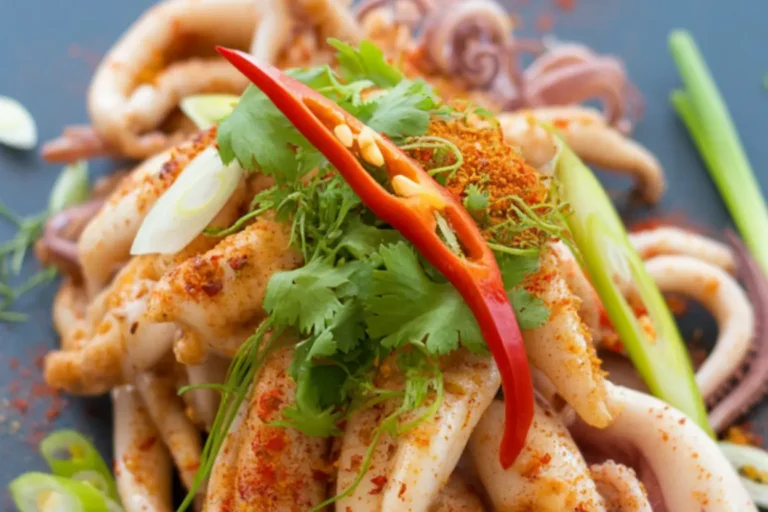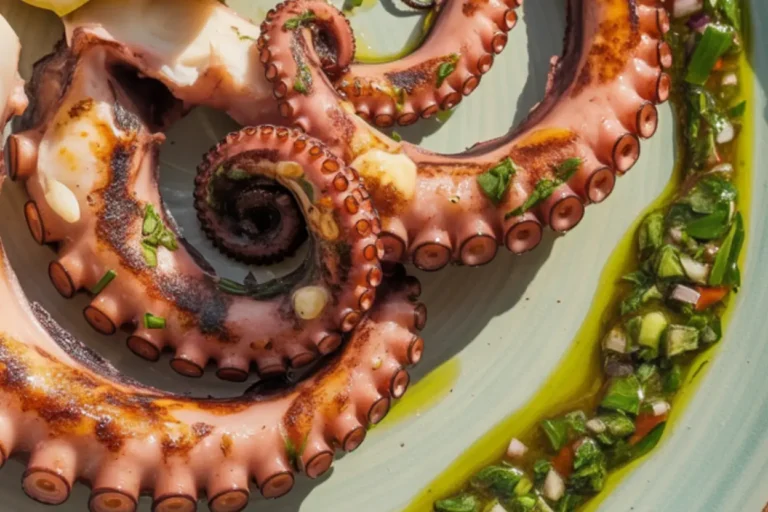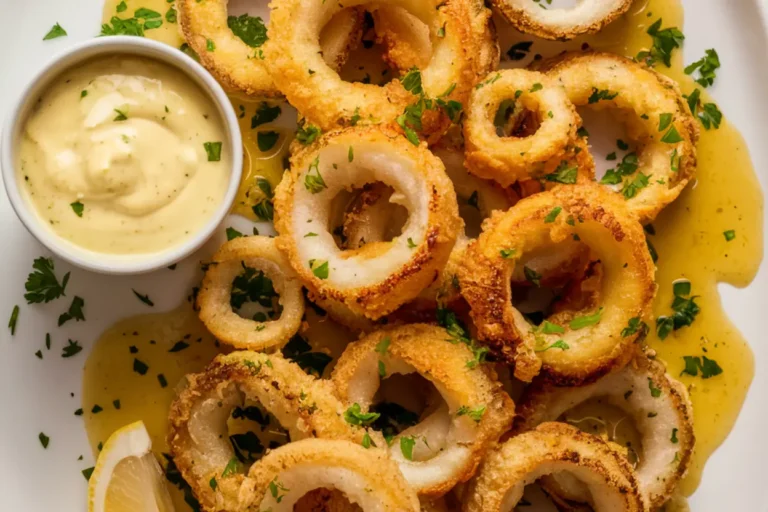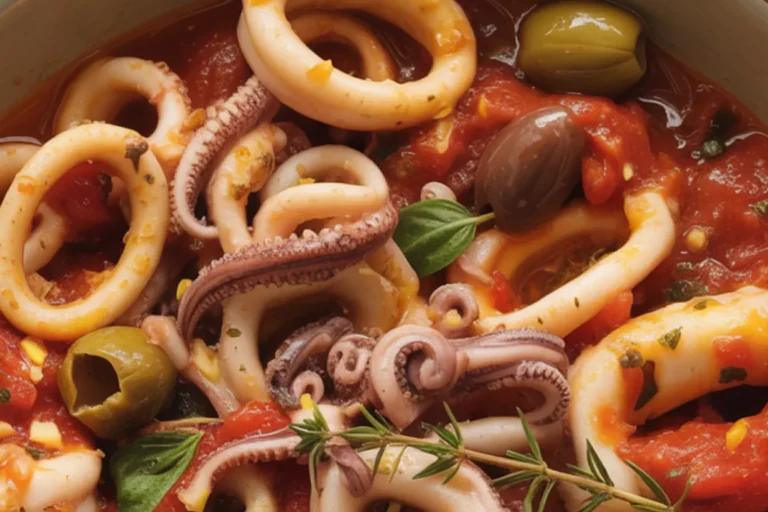Fried octopus: what makes it the best seafood snack?
Table of Contents
If you’ve ever wandered through a coastal town in the Mediterranean or strolled down a bustling street in East Asia, chances are you’ve caught the intoxicating aroma of fried octopus wafting through the air. This incredible seafood delicacy has captured the hearts (and taste buds) of food enthusiasts worldwide, and for good reason. Today, I’m breaking down exactly what makes fried octopus the ultimate seafood snack and how you can master this dish in your own kitchen.
Thank you for reading this post, don't forget to subscribe!As someone who’s spent years perfecting seafood recipes, I can confidently say that properly fried octopus delivers an unmatched combination of tender interior and crispy exterior that’s simply irresistible. Whether served as tapas, an appetizer, or a main course, this versatile dish never fails to impress guests and satisfy cravings for something special.
How to Make Fried Octopus
Quick Overview
Fried octopus turns a seemingly daunting ingredient into a crave-worthy snack that’s delightfully crisp on the outside and tender within. The key is in pre-cooking the octopus to ensure it’s perfectly tender before finishing with a quick fry for irresistible crunch. A light, flavorful coating complements—rather than overpowers—the natural sweetness of the octopus, letting its freshness shine through.
While preparing octopus does require some patience (primarily in the tenderizing phase), the actual hands-on prep time is surprisingly manageable – about 30 minutes of active preparation followed by 45-60 minutes of initial cooking and a brief 3-5 minutes for the final frying. The result is well worth the effort: golden, crispy morsels that deliver an incredible seafood experience far surpassing any restaurant version you’ve tried.
The Ingredients I Use to Bring My Fried Octopus to Life
For Pre-Cooking the Octopus:
- 2-3 pounds fresh or frozen octopus, cleaned
- 2 bay leaves
- 1 large onion, quartered
- 5 cloves of garlic, crushed
- 1 teaspoon black peppercorns
- 1 lemon, halved
- 2 tablespoons salt
For the Frying Batter:
- 1 cup all-purpose flour
- 1/2 cup cornstarch
- 1 teaspoon baking powder
- 1 teaspoon sea salt
- 1/2 teaspoon freshly ground black pepper
- 1/2 teaspoon paprika
- 1/4 teaspoon cayenne pepper (optional, for heat)
- 1 cup cold seltzer water or club soda
- 1 large egg, beaten
For Frying:
- 4 cups neutral oil with a high smoke point (vegetable, canola, or sunflower oil)
For Serving:
- Lemon wedges
- Fresh parsley, chopped
- Flaky sea salt
- Your favorite dipping sauce (aioli, marinara, or tzatziki work wonderfully)
Step-by-Step Instructions
Preparing and Tenderizing the Octopus
- Clean the octopus: If your octopus hasn’t been cleaned, remove the head sac, beak (the hard part in the center where the tentacles meet), and internal organs. Rinse thoroughly under cold running water.
- Prepare for tenderizing: In a large pot, combine 4 quarts of water with the bay leaves, quartered onion, crushed garlic, black peppercorns, lemon halves, and salt. Bring to a boil over high heat.
- Tenderize with the dipping method: Once the water is boiling, hold the octopus by the head and dip the tentacles into the hot water three times, each time for about 5 seconds. You’ll notice the tentacles beginning to curl – this helps them maintain an attractive shape during cooking.
- Simmer gently: Fully submerge the octopus in the boiling water, then immediately reduce the heat to a gentle simmer. Cover and cook for 45-60 minutes, depending on size. The octopus is done when a knife can easily pierce the thickest part of a tentacle.
- Cool properly: Turn off the heat and allow the octopus to cool in its cooking liquid for at least 30 minutes. This step is crucial for maintaining tenderness.
- Drain and dry: Remove the octopus from the cooking liquid and pat thoroughly dry with paper towels. If the octopus is large, separate the tentacles and cut into bite-sized pieces (approximately 2 inches long).
Preparing the Batter and Frying
- Create the batter: In a large bowl, mix the flour, cornstarch, baking powder, salt, black pepper, paprika, and cayenne (if using). In a separate bowl, stir together the cold seltzer water and beaten egg. Slowly pour the wet mixture into the dry ingredients, whisking until just combined. It’s okay if the batter has a few small lumps—avoid overmixing. The final consistency should resemble thick pancake batter.
- Heat the oil: In a deep, heavy-bottomed pot or Dutch oven, heat the oil to 350°F (175°C). Use a candy or deep-fry thermometer to monitor the temperature for best results.
- Coat the octopus: Working in batches, dip the dried octopus pieces into the batter, allowing excess to drip off.
- Fry to perfection: Carefully lower the battered octopus pieces into the hot oil. Fry for 3-5 minutes, turning occasionally, until golden brown and crispy. Be careful not to overcrowd the pot, which would lower the oil temperature and result in soggy octopus.
- Drain and season: Using a slotted spoon, lift the fried octopus from the oil and place it on a plate lined with paper towels to drain any excess oil. While it’s still hot, sprinkle with flaky sea salt.
- Serve immediately: Transfer to a serving plate, garnish with chopped parsley and lemon wedges. Serve with your preferred dipping sauce on the side.
What to Serve Fried Octopus With
This delightful seafood treat pairs wonderfully with a variety of sides and accompaniments:
- Traditional Mediterranean accompaniments: Lemon wedges, aioli sauce, and a simple Greek salad with cucumbers, tomatoes, olives, and feta cheese
- Asian-inspired complements: Ponzu sauce, pickled ginger, and a cabbage slaw dressed with rice vinegar and sesame oil
- Starchy sides: Crispy patatas bravas, Greek-style lemon potatoes, or even simple French fries with herb seasoning
- Fresh vegetable options: Grilled asparagus, oven-roasted bell peppers, or a fresh arugula salad with cherry tomatoes and a zesty lemon vinaigrette
- Beverages: Crisp white wines like Albariño or Assyrtiko, cold beer, or sparkling water with lemon make refreshing accompaniments
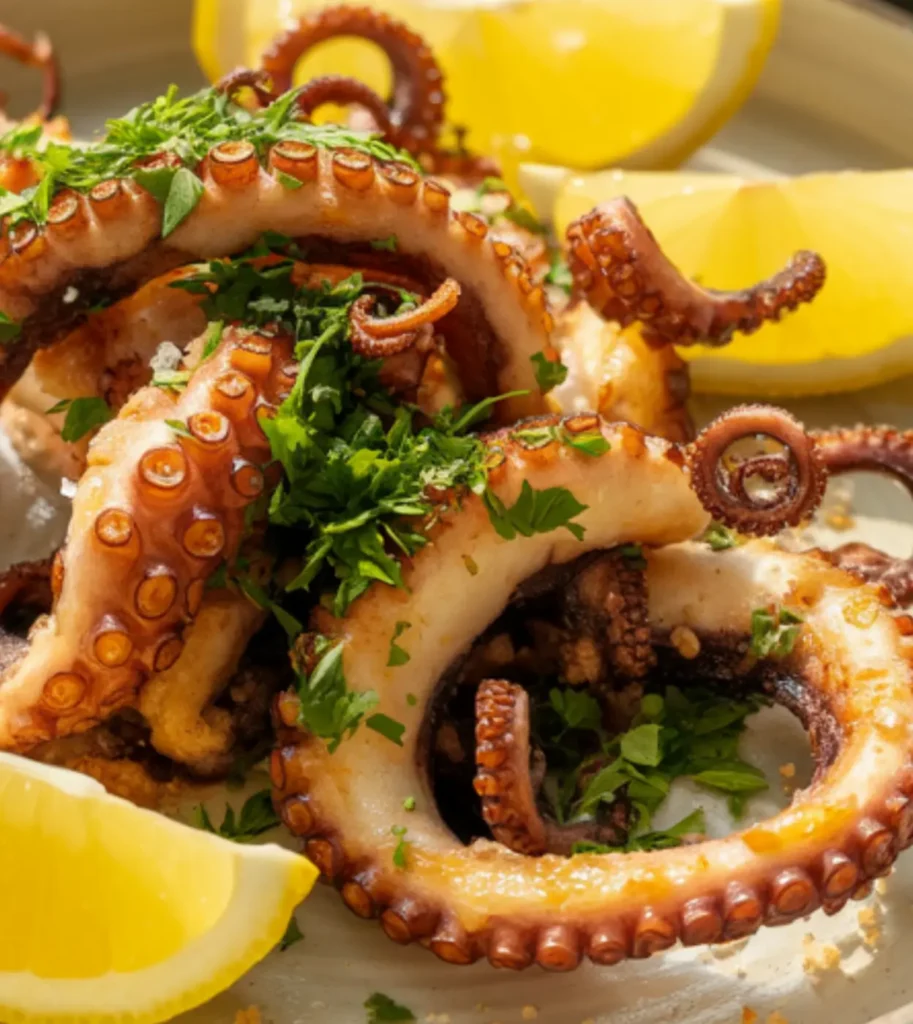
Top Tips for Perfecting Fried Octopus
- Choose the right octopus: Smaller octopuses (1-2 pounds) are generally more tender than larger ones. Fresh is wonderful, but frozen octopus often works better as the freezing process helps tenderize the meat.
- The simmer, don’t boil rule: After the initial dipping, maintain a gentle simmer rather than a rolling boil. Aggressive boiling can toughen octopus meat.
- The cooling phase matters: Allowing the octopus to cool in its cooking liquid is not optional – it’s essential for achieving tender meat.
- Temperature control is crucial: Too hot, and the batter will burn before the interior warms; too cool, and the octopus will absorb oil and become greasy. Maintain 350°F for perfect results.
- Batter consistency: The batter should be thick enough to coat the back of a spoon while still dripping off. If it’s too thick, thin it out with a bit more seltzer; if too thin, stir in flour a tablespoon at a time.
- Oil freshness: Use fresh oil for the cleanest flavor. After frying, you can strain the cooled oil and save it for another seafood frying session.
- Double-frying option: For extra crispiness, you can try the double-fry method. Fry once at 325°F for 2 minutes, allow to rest for 1 minute, then fry again at 375°F for 1 minute.
- Gluten-free adaptation: Replace the all-purpose flour with a gluten-free flour blend, and make sure the cornstarch you use is certified gluten-free.
- Don’t skip the drying step: Thoroughly patting the pre-cooked octopus dry is crucial for proper batter adhesion and to prevent dangerous oil splatter.
- Fresh herbs make a difference: Adding finely chopped fresh herbs like parsley, oregano, or dill to the batter elevates the flavor profile significantly.
Storing and Reheating Tips
Storage:
- Fried octopus is best enjoyed immediately after cooking when it’s at peak crispiness.
- If you must store leftovers, allow them to cool completely before placing them in an airtight container lined with paper towels to absorb moisture.
- Refrigerate for up to 2 days. Be aware that the crispy texture will diminish in storage.
- For pre-cooked (but not yet fried) octopus: After the initial cooking and cooling, you can refrigerate the octopus in an airtight container for up to 3 days before proceeding with the battering and frying steps.
Freezing:
- Pre-cooked octopus (before frying) freezes exceptionally well. Wrap tightly in plastic wrap, then place in a freezer bag with the air removed. Freeze for up to 3 months.
- I don’t recommend freezing already fried octopus, as the texture significantly deteriorates.
Reheating:
- For the best results with leftover fried octopus, reheat in a 375°F oven on a wire rack over a baking sheet for 5-7 minutes. This method helps restore some crispiness.
- Avoid microwave reheating, which will make the octopus rubbery and soggy.
- If reheating from frozen (pre-cooked octopus), thaw completely in the refrigerator overnight before proceeding with the battering and frying steps.
Fried octopus might seem intimidating at first glance, but this step-by-step guide breaks it down into an achievable culinary adventure. The combination of tender, flavorful octopus encased in a light, crispy coating creates an unforgettable seafood experience that might just become your new signature dish. Whether you’re serving it as an impressive appetizer or enjoying it as a satisfying snack, fried octopus delivers restaurant-quality results that are sure to impress even the most discerning seafood lovers. Give it a try – your taste buds will thank you!
Fried octopus: what makes it the best seafood snack?
Cuisine: MediterraneanDifficulty: Intermediate4
servings30
minutes12
minutes400-450
kcalCrispy, golden, and tender, this fried octopus recipe turns a traditionally intimidating seafood into a crowd-pleasing, restaurant-quality snack or appetizer. Pre-cooked for tenderness, then lightly battered and fried, the octopus boasts a crunchy exterior while staying juicy and flavorful inside. Finished with lemon, flaky sea salt, and fresh parsley, it’s perfect for dipping in your favorite sauces.
Ingredients
2-3 pounds fresh or frozen octopus, cleaned
2 bay leaves
1 large onion, quartered
5 cloves of garlic, crushed
1 teaspoon black peppercorns
1 lemon, halved
2 tablespoons salt
1 cup all-purpose flour
1/2 cup cornstarch
1 teaspoon baking powder
1 teaspoon sea salt
1/2 teaspoon freshly ground black pepper
1/2 teaspoon paprika
1/4 teaspoon cayenne pepper (optional, for heat)
1 cup cold seltzer water or club soda
1 large egg, beaten
4 cups neutral oil with a high smoke point (vegetable, canola, or sunflower oil)
Lemon wedges
Fresh parsley, chopped
Flaky sea salt
Your favorite dipping sauce (aioli, marinara, or tzatziki work wonderfully)
Instructions
- Tenderize the Octopus
Clean the octopus if needed, then bring a large pot of water to a boil with bay leaves, onion, garlic, peppercorns, lemon halves, and salt. Dip the octopus tentacles into the boiling water three times to curl them, then fully submerge and simmer gently for 45–60 minutes until tender. Let the octopus cool in the cooking liquid for at least 30 minutes. Once cooled, remove, pat dry, and cut into 2-inch pieces if needed. - Batter and Fry
In a bowl, mix the flour, cornstarch, baking powder, salt, pepper, paprika, and cayenne. In a separate bowl, whisk together cold seltzer and beaten egg, then combine with the dry ingredients to make a thick batter. Heat oil in a deep pot to 350°F (175°C). Dip the octopus pieces in the batter, let excess drip off, and fry in batches for 3–5 minutes until golden and crispy. Drain on paper towels, season with flaky sea salt, and serve hot with lemon wedges, chopped parsley, and your favorite dipping sauce.
Notes
- Octopus can seem tricky to work with, but once it’s pre-cooked to tender perfection, it fries up easily and beautifully. The secret to success lies in a light, airy batter (thanks to cold seltzer and a touch of baking powder), and quick frying at high heat. Serve it hot with lemon wedges and your favorite dip, whether it’s garlicky aioli or refreshing tzatziki, for a dish that’s sure to impress.

